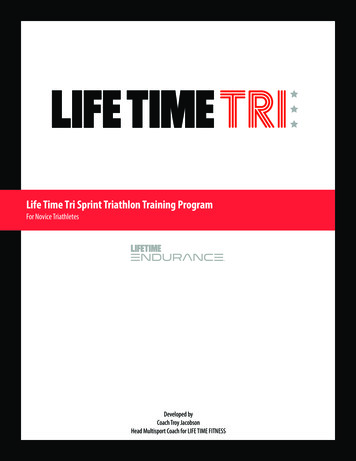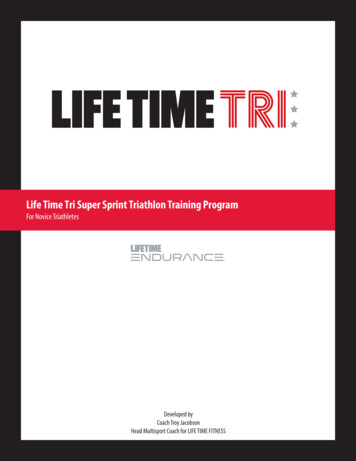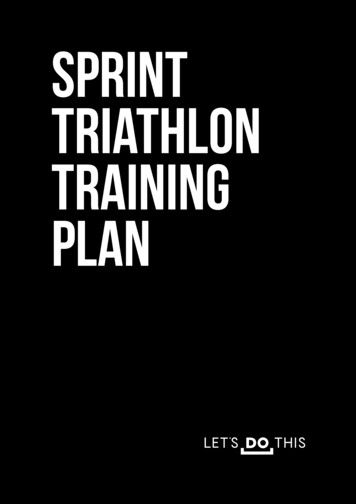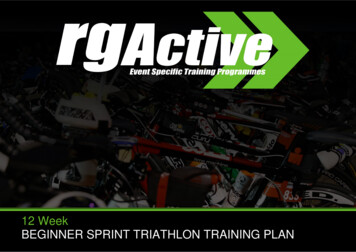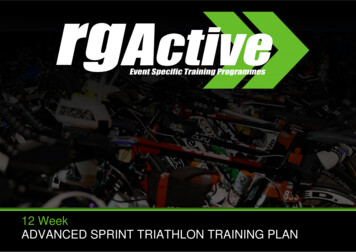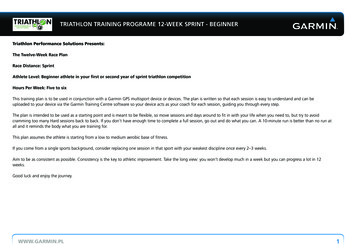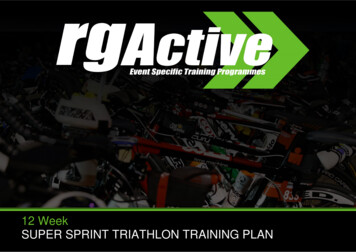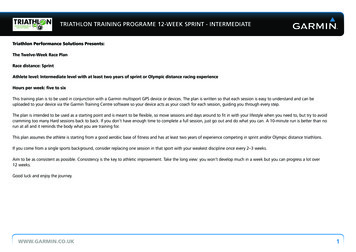
Transcription
A Total Sprint-Training Program forMaximum Strength, Power, Sprint Speed & Core Strengthby Jim Hiserman, C.S.C.SThe recent article on 400/800 lactate tolerance workouts for 400 sprinters brings up thediffering opinions of SHORT TO LONG vs. LONG TO SHORT philosophies.I am currently consulting former athletes who are now in the “higher volume, shorterrests, slower speeds builds strength” type programs. While the concept of “buildingspeed/strength endurance” through this method of training for 400 meters has beenstrengthened by the Clyde Hart approach, it is necessary to re-visit the PROVENPRINCIPLES of Speed Development that apply to the 400 meters as well.Unless coaches are blessed with athletes like Michael Johnson, Jeremy Wariner or SanyaRichards, it is best to remember that there are various types of physiologies that can besuccessful at sprinting over 400 meters and no ONE METHOD fits everyone.There are, however, some basic bio-mechanical principles that must enter into thedevelopment of sprinters regardless of the sprint race distance (60-400 meters).The Sprint Training Goal should be aimed at getting athletes to develop and properlyexecute FRONT SIDE MECHANICS at Maximum Velocity. If this seems odd to coachesinvolved with training 400 meter runners it might be best to examine a few criticalprinciples of sprint biomechanics that will affect sprinting at all distances. Sprinters who spend more time on the Front Side Mechanics will be the faster atall sprint distances given everything else being equal. Forces produced during the first half of Ground Contact are greater than thoseproduced in the last half (Front Side Mechanics vs. Back Side Mechanics). Faster sprinters are those that end their Ground Contact earlier and reduce thetime needed to get back to Front Side Mechanics. Once an athlete reverts back to Back Side Mechanics due to fatigue, they cannotregain Front Side Mechanics and are limited to the inferior BSM and resultantinferior performance.Obviously, a more efficient sprinter reduces Horizontal Braking Forces with properFront Side Mechanics. It is also apparent that the sprinters who spend more time on theFront Side of Ground Contact will be the faster/more effective and efficient sprinters.Mixed workouts such as 3 x 40m w/2’ & 5’, 1 x 250m Race Model w/10’, 3 x 30m w/2’ &5’, 1 x 180m Race Model will help to develop high speed sprint mechanics in addition toproviding the speed endurance/ lactate tolerance necessary for 400 meter training, yet itis easier to find more high schools using a 5 x 300 w/ 5’( at 85% of 400 pace) workout tobuild that “strength”.Copyright 2009 by Jim Hiserman, C.S.C.S., reprinted courtesy of Speedendurance.com
The Million Dollar Question for coaches to answer is this: How in the world do youteach such high speed, properly programmed Central Nervous System movementswithout incorporating precise and high speed sprinting throughout the entire trainingyear?Why are there so many coaches who spend all Fall with slower paced, higher volumework that gradually transitions from extensive tempo type work to intensive tempowork?Why can’t high-speed work exist year round in varying amounts?I think it would be worthwhile for coaches to take a look at the LSU and Texas A&MFall, Winter and Spring Sprint Workout Plans. Texas A&M, with Pat Henry bringing theLSU Model with him to College Station, has begun the foundation for turning out worldclass performers in the future.LSU (under coaches Henry and Shaver) has consistently produced high-level sprinters(100,200 and 400), hurdlers (short and 400H) and relay teams over almost two decades.What is important to note is NOT that they get high-level talent BUT their sprinters andhurdlers continue to develop after their collegiate eligibility has expired. Most continuewith the same training system (LoLo Jones) with people like Muna Lee re-emerging onthe World Scene after training in other systems and returning to work with CoachHenry.For coaches willing to examine the elements necessary for the development of sprinttraining programs, there is much to be gained by looking at those programs that havebeen CONSISTENTLY successful at developing their athletes from year to year.There is an enormous amount of research-proven information availableIn regards to sprint performance -- covering such areas as sprint mechanics, hurdle mechanics,energy-system physiology, strength training, power training, plyometrics, proper warm-up, coredevelopment, race models, etc.But simply knowing all the components is not enough. The challenge is to take all this relevantknowledge and communicate it to athletes in the form of a structured and progressive trainingprogram.The challenge in designing such a “Total Sprint-Training Program” for collegiate and/orhigh school sprinters and hurdlers is to balance the workloads between the sprintworkouts and the weight room for each day and week, and to make sure that theyfollow the same weekly emphasis.This integration of training for (1) maximum strength/power, (2) core strengthtraining, and (3) maximum sprint speed, should be the desired goal of sprint/hurdlecoaches.Copyright 2009 by Jim Hiserman, C.S.C.S., reprinted courtesy of Speedendurance.com
The program design should be constantly upgraded using the latest research findings. Inaddition, integration of successful training from many of the successful coaches whohave shared their methods of sprint training in articles, books and seminars should bean ongoing process of upgrading training programs.The design of a successful program combines all the vital components that have beenshown to improve sprint performance into an effective and periodized plan -- one thatcan be adapted to the individualized needs of the various talent levels that may existwithin any specific training group.Through frequent testing, the appropriate and specific volumes and intensities of thevarious training components can be prescribed on an individual basis without any otherdeviation from the day’s workout.This type of program design provides a model for the creation of sprint programscapable of providing improvements in the strength, power, speed and speed enduranceof athletes over a number of years as well as the current season. It also provides forindividual program adjustments so that athletes can continue to move to higher levels.[NOTE: Sprinting and hurdling are closely related -- the development of maximumspeed is a primary factor in hurdle training as well as sprint training. Although there isnothing about hurdling technique in these articles, the program design template ismeant to apply to hurdlers as well as sprinters. The blending of components for hurdleskill and rhythm into the daily workout plans where they apply can be done on anindividual basis depending on the skill levels of hurdlers involved.PROGRAM DESIGN OVERVIEW: The Basic ElementsThe basic elements of the training program model to improve sprint performance willinclude the following concepts:1) Development of a Yearly Periodized Plan2) Development of a Dynamic Stereotype (Basic and Advanced Technical Models ofSprinting) rehearsed at high velocity3) Development of Maximum Speed4) Development of Maximum Strength5) Development of Maximum, Functional Power6) Development of Core Strength (specific to sprint/hurdle posture demands)7) Development of Specific Strength for tendons and muscles of lower leg and ankle8) Development of Energy Systems Specific to Sprint Distances9) Development of Specific Testing Protocols and Testing Intervals10) Development of Specific Warm-up Patterns for items 2-7 aboveAs noted, the challenge is to design a plan where the various elements can bemixed in the right proportions, in the proper sequences, at the right times, usingexercises that are the most functional -- so that the blending of all the elementsCopyright 2009 by Jim Hiserman, C.S.C.S., reprinted courtesy of Speedendurance.com
results in the desired improvement of sprint performance. Obviously, it is vitalto prioritize all the elements so that one or more does not get lost in the process.SPEED AND STRENGTH ARE THE KEYSThe two most important elements in the sprint training program plan are: 1) maximumspeed training and 2) maximum strength training. They form the foundation of thetraining plan.Laying the Neuromuscular FoundationThe key to training these two main building blocks of sprint training is the training ofthe Central Nervous System (CNS).This training is twofold. The CNS must be trained to lay down a proper and sequentialpattern of stereotyped sprint movements that are rehearsed at high speeds. This is thedevelopment of a Technical Sprint Model.In addition, the (CNS) must be stimulated to develop more Motor Units (MU’s), throughenhancing the recruitment of large, fast-twitch MU’s first, so that improvements inpower can occur and increase the frequency that the MU’s are activated.It is vital that a coach has the proper background information regarding the teaching ofthe Technical Sprint Models and the role that maximum strength development plays inthe development of maximum speed and maximum, functional power. Therefore, thesetwo critical and foundational components of sprint training will be developed in greaterdetail.The base for speed IS speed.Improvements in maximum strength allow for improvements in speed. Although thenature of this series of articles is to provide a guide to sprint/hurdle programdevelopment, I believe it is vital to give a complete background of proper sprintmechanics along with the rationale for the parallel emphasis on maximum strengthtraining. My hope is that the important background information on these two criticaland inter-dependent components will provide the base knowledge for keeping trainingprograms from straying away from the necessary core of sprint performance training.TRAINING FOR DEVELOPMENT OF MAXIMUM SPEEDSpeed is a skill that must be constantly rehearsed. The secret to training any motor skilllies in the training of the Central Nervous System (CNS). Successful training for speeddevelopment is mostly neural in nature. Although sprinting is a product of manytraining factors (see 1-9 above), neuromuscular training must be the primary focuswhere maximum speed development is concerned.Copyright 2009 by Jim Hiserman, C.S.C.S., reprinted courtesy of Speedendurance.com
Programming athletes to perfect the proper technical model of sprinting is where sprinttraining should begin. It must be emphasized that this training is neural and notmetabolic. Therefore, proper training to perfect the technical model of sprinting has tobe done at event speed, or close to it, with proper rest between drills so that the nervoussystem is not fatigued.Programming an individual to sprint properly at high speeds requires knowledge of thefour developmental stages necessary for development of any athletic skill. The fourstages are:1.2.3.4.Develop strength and power.Develop technical model of a skill or event.Develop advanced levels of strength and power.Develop advanced technical model of a skill or event.In designing a successful program for speed development it is important to understandthat the development of strength/power and the development of the basic technical modelof sprinting, can be (and should be) developed at the same time. Athletes must be strongenough to learn the basic technical model. This basic model involves work aimed atneuromuscular coordination. This work has two components: 1) Intra-MuscularCoordination, and 2) Inter-Muscular Coordination.Intra-Muscular is work primarily concerned with specific sensory muscle componentsand the corresponding specific motor unit output.In programming the model of sprint technique it is not necessary to have a greatstrength and power base. It is therefore appropriate to train strength and powerconcurrently with neuromuscular coordination involved in proper sprint mechanics. Inaddition, it is “vital” that Core Strength Development be integrated into the entire planso that the postural demands of pelvic and trunk stabilization necessary for efficientsprint mechanics can be mastered.The most important rule in teaching sprint mechanics is to make sure the basic technicalmodel has been mastered before introducing the advanced technical model. In additionto perfecting the basic technical model of sprinting the athlete must also have developedadvanced levels of strength and power before trying to master the advanced technicalmodel. Without advanced levels of specific power, the athlete will not have thenecessary tools to master the advanced sprint model. The vital element of this sprintspecific power development is ELASTIC POWER.With the development of sprint-specific/elastic power and the mastering of theadvanced sprint model, athletes can complete the equation for successful sprinting.POWER COORDINATION SPEED.The importance of perfecting the technical sprint model cannot be over emphasized.The perfecting of intra- and inter-muscular coordination that is necessary to produce aCopyright 2009 by Jim Hiserman, C.S.C.S., reprinted courtesy of Speedendurance.com
"motor program" takes hundreds of hours! Because of this it is important to emphasizeextreme focus on each individual sprint drill.In addition to sprint drills, special attention must be placed on proper execution ofsprints done at 95%-100% of maximum speed with rests long enough to allow forcomplete recovery of the CNS.There are four levels of skill performance. These include:1)2)3)4)Unconscious incompetence,Conscious incompetence,Conscious competenceUnconscious competence (automatic competence).A successful sprint program provides for progressive development of athletes so thatthey are ultimately able to "unconsciously" execute proper sprint mechanics atmaximum velocity.The constant utilization of task-specific cues by both coach and athlete is necessary fordevelopment of the "automatic competence" found at the top level
The two most important elements in the sprint training program plan are: 1) maximum speed training and 2) maximum strength training. They form the foundation of the training plan. Laying the Neuromuscular Foundation The key to training these two main building blocks of sprint training is the training of the Central Nervous System (CNS).File Size: 207KBPage Count: 10




